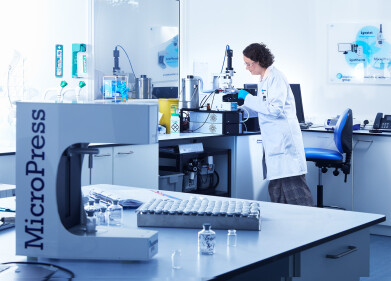Laboratory Products
High-End Titration System Increases Productivity and Efficiency in the Modern Laboratory
Feb 08 2019
OMNIS is the high-end titration system from Metrohm. It provides users with the possibility to consolidate their wet chemical analysis on a universal platform. With this comes the flexibility to expand and customise this platform as their business grows. Automation possibilities hitherto simply not available help taking productivity to the next level.
OMNIS gives laboratories the flexibility to respond to new challenges as they arise. Hence, the platform can be expanded at any time to provide additional capacity for new applications and/or higher sample throughput. This is done by adding the required hardware, e.g. another titration module, another work station, or even a robotic autosampler to the existing platform.
OMNIS boosts efficiency with the possibility to perform several tasks in parallel. Here is an example: While a titration is performed in a sample on one workstation of the OMNIS Sample Robot, the next sample is already being prepared on another workstation. A third and fourth workstation may be used to further integrate the same application or to perform different ones - simultaneously.
The modularity of OMNIS includes the possibility to increase sample throughput by automation. Hence, throughput can be pushed in increments from 50 to 125 to 175 samples based on the x-y-z system of the OMNIS Sample Robot. Peak performance is defined by four titrations performed simultaneously at four workstations to analyse 175 samples completely unattended.
Basically, OMNIS provides a construction kit of discrete functional steps, which can be freely combined and used over and over again. Thus, customised operating procedures can be built block by block with the least possible effort.
Users want to know the concentration of parameters x, y, and z in their samples. In reality, this all too often means collecting results from different determinations or method specific data bases and aggregating them with considerable effort. Not so with OMNIS: All results are connected to the sample in the sample profile and shown to the user at a single glance.
Measuring a particular sample may require several different methods to be performed in a specific order. If whole series of samples have to be analysed, maintaining an overview becomes a challenge. Not so with OMNIS: Users can open the sample profile at any time to see, which samples (and parameters) have already been analysed and which are next.
Digital Edition
ILM 49.5 July
July 2024
Chromatography Articles - Understanding PFAS: Analysis and Implications Mass Spectrometry & Spectroscopy Articles - MS detection of Alzheimer’s blood-based biomarkers LIMS - Essent...
View all digital editions
Events
ACS National Meeting - Fall 2024
Aug 18 2024 Denver, CO, USA
Aug 25 2024 Copenhagen, Denmark
Aug 28 2024 Phnom Penh, Cambodia
Sep 04 2024 Chiba, Tokyo, Japan
Sep 04 2024 University of Warwick, Coventry, UK


















